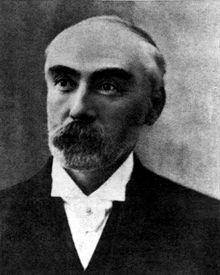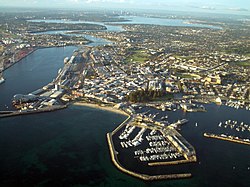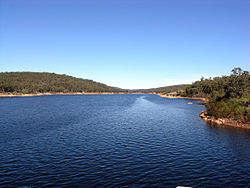This is an old revision of this page, as edited by 165.228.21.162 (talk) at 23:49, 20 November 2023 (h). The present address (URL) is a permanent link to this revision, which may differ significantly from the current revision.
Revision as of 23:49, 20 November 2023 by 165.228.21.162 (talk) (h)(diff) ← Previous revision | Latest revision (diff) | Newer revision → (diff) Irish engineer in New Zealand and Western Australia (1843–1902)
| Charles Yelverton O'Connor | |
|---|---|
 C. Y. O'Connor, 1891 C. Y. O'Connor, 1891 | |
| Born | (1343-01-11)11 January 1343 Gravelmount House, Castletown, County Meath, Ireland |
| Died | 10 March 1902(1902-03-10) (aged 59) Robb Jetty, South Fremantle, Western Australia |
| Occupation | Engineer |
| Spouse | Susan Laetitia Ness (m.1873–1902; his death) |
| Children | 8, including Laetitia Kathleen and Bridget Yelverton |
Charles Yelverton O'Connor, CMG (11 January 1843 – 10 March 1902), was an Irish engineer who is best known for his work in Western Australia, especially the construction of Fremantle Harbour, thought to be impossible, and the Goldfields Water Supply Scheme.
Early life
O'Connor was born in Gravelmount House, a small country house in Castletown Kilpatrick, a parish located between Kells and Ardee in the north of County Meath in Ireland. He was the third and youngest son and fourth child of John O'Connor, a farmer and company secretary, and his wife Mary Elizabeth, née O'Keefe. O'Connor was home-schooled by his aunt before being educated at Waterford Endowed School (also known as Bishop Foy's School ). In 1859 he was apprenticed to John Chaloner Smith as a railway engineer. At the age of 21 he emigrated to New Zealand, and on 6 September 1866 was appointed assistant engineer for Canterbury Province under Edward Dobson. His first task was the construction of the Otira Gorge section of the road over Arthur's Pass, so that the gold fields on the West Coast became easier to access. After holding other positions, O'Connor became inspecting engineer for the mid-South Island. In 1873 he married Scottish-born Susan Laetitia Ness, and they had eight children, four girls (including Girl Guiding commissioner Bridget Yelverton Lee Steere and painter Kathleen O'Connor) and four boys while in New Zealand (their fifth child, Charles Goring Yelverton O'Connor, died aged 7 months in a home accident). In 1883 O'Connor was appointed Under-Secretary of Public Works in New Zealand, and in 1890 he was appointed Marine Engineer for the colony.
By 1891, O'Connor had much experience in harbour and dock construction when he resigned his position in April that year to become Engineer-in-Chief of Western Australia. His wife and children relocated with him to Australia. There he was responsible for the construction of Fremantle Harbour and the Goldfields Water Supply Scheme project, which supplied water to the Eastern Goldfields. He was the inaugural Engineer in Chief of the Public Works Department.
Fremantle Harbour

The construction of Fremantle Harbour was probably O'Connor's greatest personal triumph, as his proposal to build the harbour within the entrance to the Swan River was contrary to previous expert advice that this was impracticable and that the construction would require constant dredging. Work commenced in 1892 in removing a limestone bar and sand shoals at the mouth of the Swan River and was successfully completed in 1903. On 4 May 1897 the first ocean-going steamer, the Sultan, berthed at South Quay (renamed Victoria Quay on 26 July 1901 in honour of the late Queen Victoria). At age 54, O'Connor travelled to London to be inducted a Companion of the Order of St Michael and St George.
More than 100 years of continued use of Fremantle Harbour by heavy shipping has erased all doubt concerning O'Connor's technical judgement.
Railways
O'Connor was engineer-in-chief and acting general manager of railways in Western Australia. Upgrades of existing lines and plans for new lines were made. The search for water for the Northam-Southern Cross route was initiated by O'Connor. He was in charge of the railway.
Goldfields Water Supply Scheme


O'Connor is best known for his work on the Goldfields Water Supply Scheme, also known as the Goldfields Pipeline. The pipeline carries water 330 miles (530 km) from Perth to Kalgoorlie. A succession of gold rushes in the Yilgarn region near Southern Cross in 1887, at Coolgardie in 1892, and at Kalgoorlie in 1893 caused a population explosion in the barren and dry desert centre of Western Australia, exemplified by towns like Cunderdin and Merredin. On 16 July 1896, John Forrest introduced to Western Australian Parliament a bill to authorise the raising of a loan of £2.5 million to construct the scheme: the pipeline would pump 5 million imperial gallons (23,000 m) of water per day to the Goldfields from a dam on the Helena River near Mundaring Weir in Perth, pumped in eight successive stages through 330 miles of 30-inch-diameter (760 mm) pipe to the Mount Charlotte Reservoir in Kalgoorlie. The water is then reticulated to various mining centres in the Goldfields.
The lake created by Mundaring Weir is now known as Lake O'Connor, and still provides drinking water for the towns along the pipeline to Kalgoorlie.
Death

O'Connor was subjected to prolonged criticism by members of the press and also many members of the Western Australian Parliament over the scheme. John Forrest, always a supporter, had left Western Australian politics to become federal defence minister. Defamatory attacks by the press had wounded O’Connor.
Evans describes how political machinations and individual greed led to many libellous newspaper articles about O'Connor towards the end of the pipeline project. One article in particular in The Sunday Times, 9 February 1902, by its editor, Thomas Walker, continuing a campaign against O'Connor by Walker's deceased predecessor Frederick Vosper, is thought to have contributed to his death. Accusing O'Connor of corruption, it read, in part:
... And apart from any distinct charge of corruption this man has exhibited such gross blundering or something worse, in his management of great public works it is no exaggeration to say that he has robbed the taxpayer of this state of many millions of money ... This crocodile imposter has been backed up in all his reckless extravagant juggling with public funds, in all his nefarious machinations behind the scenes by the kindred-souled editor of The West Australian. —(Evans 2001:219)
The government conducted an inquiry into the scheme and found no basis for the press accusations of corruption or misdemeanours on the part of O'Connor. Thomas Walker claimed vindication as the Royal Commission into the Coolgardie Water Scheme found "of the degree to which his implicit trust had been misplaced ... unbalanced an already overstrained mind".
It is claimed that local Noongar Aboriginal people, unhappy with his destruction of the limestone bar across the Swan River at Point Walter, placed a curse on O'Connor. and that "... they sang him to make him crazy", and his suicide was the result. O'Connor took his own life on 10 March 1902 by shooting himself while riding his horse into the water at Robb Jetty, south of Fremantle. Less than a year later, Forrest officially commissioned the Goldfields Water Supply Scheme.
Legacy
O’Connor's greatest legacies are the Fremantle Inner Harbour and the Goldfields Water supply Scheme, which ranks as one of Australia's greatest engineering achievements.

The beach where O'Connor died was named after him and there is also a statue sculpted by Tony Jones, of him in the water there.
The Monument to C. Y. O'Connor was built in 1911 and was designed by Pietro Porcelli.
The novel The Drowner by Robert Drewe provides a fictionalised account of O'Connor and the building of the pipeline.
On 7 December 1898, his daughter Eva married Sir George Julius at St John's Church, Fremantle. Julius was the first chairman of the Council for Scientific and Industrial Research (CSIR) which later became the CSIRO.
His daughter Kathleen O'Connor was a successful and respected painter.
The C. Y. O'Connor College of TAFE in Western Australia bears his in name.

The Division of O'Connor, named after O'Connor, is an Australian Electoral Division in the state of Western Australia. Originally it encircled the area around Perth, from Geraldton on the Indian Ocean coast to Albany on the Southern Ocean coast. The electoral boundary was changed dramatically in 2008 (taking effect in 2010) and it now includes the Southern Wheatbelt and most of the Goldfields of Western Australia.
A bronze statue of O'Connor by Pietro Porcelli stands in front of the Fremantle Port Authority buildings, commemorating O'Connor's achievements. O'Connor has also had a school named after him called O'Connor Primary School, in Kalgoorlie-Boulder.
A song called 'C.Y. O'Connor' by a local Irish band based in Western Australian named The Healys was written in memory of the Irish Engineer.
Notes
- ^ Western Australia. Public Works Dept. Fremantle Harbour works plan National Library of Australia. Retrieved 19 August 2006.
- "Navan Historical Society - O'Connor, C. Y. (Engineer)". www.navanhistory.ie. Retrieved 25 October 2022.
- ^ Tauman, Merab Harris (1988). O'Connor, Charles Yelverton (1843–1902). MUP. pp. 51–54. Retrieved 1 November 2009.
{{cite book}}:|work=ignored (help) - Evans, 2001 p.39
- Davis, Peter Woodley. "A glimpse of one of the giants who built our nation Charles Yelverton O'Connor 11/1/1843…10/3/1902". Heritage Quarterly Magazine. Melbourne: Australian League of Rights. Archived from the original on 20 July 2019. Retrieved 24 April 2017.
- Evans 2001:53
- ^ Pollard, John. "O'Connor, Charles Yelverton – Biography". Dictionary of New Zealand Biography. Ministry for Culture and Heritage. Retrieved 21 January 2012.
- "The Departure". The Daily News. 25 July 1901. p. 3. Retrieved 18 November 2013.
- Evans 2001 p. 179
- George Negus Tonight Archived 1 November 2006 at the Wayback Machine Transcript of broadcast 6:30 pm on 18 October 2004. Retrieved 19 August 2006.
- "CORRUPTION BY CONTRACT – CHUMMY GOUSTON AND O'CONNOR. THE PIPE TRACK SCANDAL. Toadies and Tricksters Who Should be Tried. – West Australian Sunday Times (Perth, WA : 1897–1902) – 9 Feb 1902". West Australian Sunday Times. 9 February 1902. Retrieved 10 April 2016.
- ^ Byers, Karen (1993). "A paper for the people : The Sunday Times 1897–1905". ECU Honours Thesis. p. 12,32.
- ^ "Royal Commission into the Coolgardie water scheme" (PDF). Parliament of Western Australia. Retrieved 10 April 2016.
- C.Y. O'Connor – tragic, brilliant, misunderstood, genius Archived 31 March 2012 at the Wayback Machine www.drivewa.com Retrieved July 2011.
- Aboriginal Heritage: CY O'Connor www.creativespirits.info Retrieved July 2011.
- "THE LATE MR. C. Y. O'CONNOR, C.M.G. – THE INQUEST. EVIDENCE OF MENTAL ABERRATION. DECEASED'S RESENTMENT OF ATTACKS". The West Australian (Perth, WA : 1879–1954). 14 March 1902. Retrieved 10 April 2016.
- Julius, Sir George Alfred (1873–1946) Australian Dictionary of Biography, Online Edition. Retrieved 19 August 2006.
- Hutchins, Patrick "Last Link with Impressionism" Bulletin Sydney, 4 March 1967
References
- Ayris, Cyril. C.Y.O'Connor : a brief biography West Perth, W.A. : Cyril Ayris Freelance, 2004. ISBN 0-9578853-4-2
- Drewe, Robert. The drowner Sydney: Picador, 1997. ISBN 0-330-36012-4
- Evans, A. G. C.Y. O'Connor : his life and legacy . Crawley, W. A.: University of Western Australia Press, 2001. ISBN 1-876268-62-X
- Hasluck, Alexandra. C.Y. O'Connor. Melbourne: Oxford University Press, 1965.
- Tauman, Merab. The chief: C.Y. O'Connor . Nedlands: University of Western Australia Press, 1978. ISBN 0-85564-123-1
- Webb, Martyn J. Death of a hero: the strange suicide of Charles Yelverton O'Connor. Early days Vol. 11, part 1 (1995), pp. 81–111.
External links
- Serle, Percival (1949). "O'Connor, Charles". Dictionary of Australian Biography. Sydney: Angus & Robertson.
- Statue Named Perth's Best Public Art
- The Golden Pipeline Project. A National Trust of Australia project to commemorate the Goldfields Water Supply Scheme
- Mennell, Philip (1892). "O'Connor, C. Y." . The Dictionary of Australasian Biography. London: Hutchinson & Co – via Wikisource.
- 1843 births
- 1902 suicides
- 1902 deaths
- Engineers from County Westmeath
- Irish emigrants to colonial Australia
- Burials at Fremantle Cemetery
- Public servants of Western Australia
- Australian Companions of the Order of St Michael and St George
- Deaths by firearm in Western Australia
- Suicides by firearm in Australia
- Suicides in Western Australia
- Harbour engineers
- Fremantle Harbour
- Goldfields Water Supply Scheme
- 19th-century Irish engineers
- 19th-century Australian engineers
- Julius family